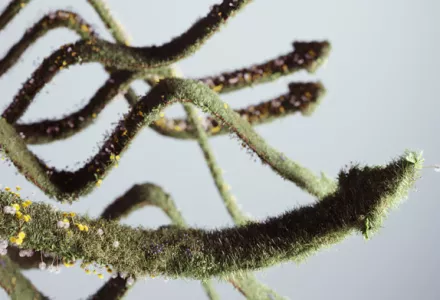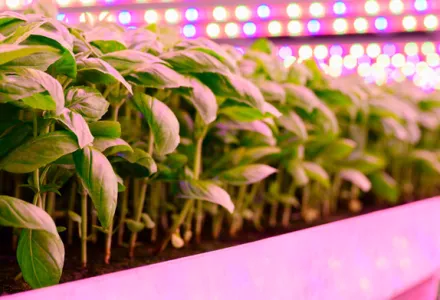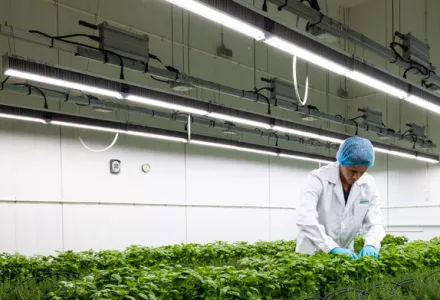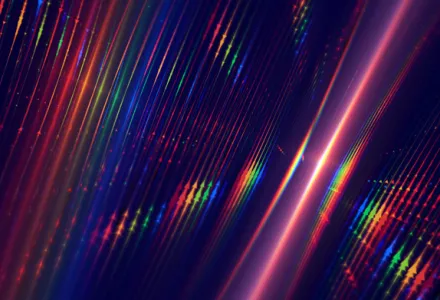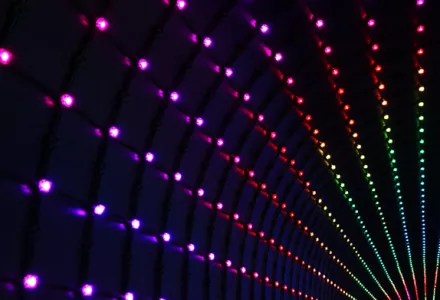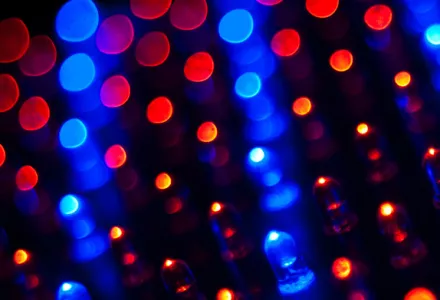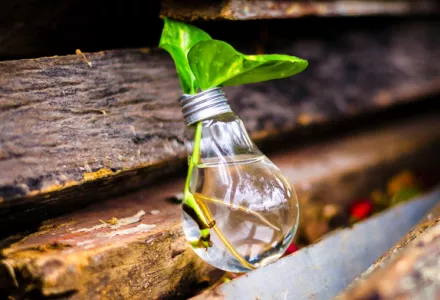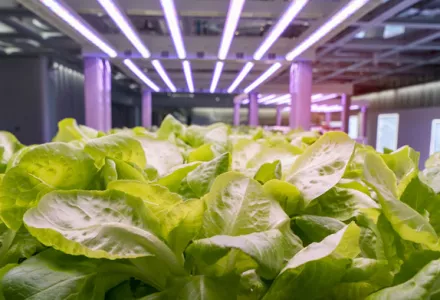Light is essential for every plant. Chlorophyll allows plants to convert energy from light into sugars. Does light impact plants in ways other than just supplying them with energy? Do the colours even influence a plant’s growth and development? This article reviews these and other questions.
The primary colours
Researchers have traditionally distinguished seven colours, the colours of the rainbow, red, orange, yellow, green, blue, indigo and violet. We may call these the primary colours. Put together, the primary colours create white light and are visible when a ray of sunshine is split by a prism.
Objects can absorb the colours in light, let them pass through or reflect them. Science tells us that objects themselves possess the colours they do not absorb. Because plants do not absorb green they must themselves be green. There are those who claim that light measurements show that plants themselves emit light particles in the dark and hence actively help create their own colour.
Just as we do, plants sense the light and colours surrounding them – but in a different way! But that’s not the only thing the plants senses, a recent study states that also music and air temperature affects the plant.
Effect of red light on plant growth
Plants are sensitive to red in the light spectrum, a sensitivity that arises from the plant having what is called a red light photoreceptor. The receptor is a blue-green pigment termed a phytochrome present in the cells of a plant. You might think of phytochrome as an eye that only senses red light.
Red light impacts a plant in many ways. Plants that are grown in plenty of red light are often large, but in general are also tall with plenty of branches. If the photoreceptor picks up a large quantity of natural red light, for example in the summer when there’s plenty of natural red light, production of a plant hormone (meta-topolin) is increased. This hormone prevents the chlorophyll in the plant being broken down, so that it stays green in the spring and summer. And that is only beneficial, for it is precisely at this time that the plant needs its chlorophyll to convert energy coming from the sun into sugars.
Red light also influences a plant’s flowering and seed production

Source: www.physik.uni-stuttgart.de
Using the quantity of red compared to the amount of far-red in the light the plant decides whether to start flowering. The flowering period can be extended by exposing the plant during the darker period to red-containing light. It will then take longer before you can harvest which of course you don’t want! This explains why it is unwise to enter the growing area when it’s dark.
The red colour in light also influences flavour because it increases the concentration of special oils in plants. The leaves may have a more bitter taste.
If you want to get seeds from your plants, and you’re looking for possible 'female' seed then you need to avoid exposing your plants to excessive red light, because this will cause many seeds to grow, 'if applicable', into male plants. Unless you want it the other way round of course.
Effect of blue light on plant growth
Plants see blue light as well as red light, using a photoreceptor that is called a cryptochrome. If there is plenty of blue light, as in nature during the autumn and winter, this receptor dampens the operation of a plant hormone called auxin. This hormone is responsible for the plant’s stem growth. Auxin is also responsible for what is referred to as ‘apical dominance’, the phenomenon whereby growth points ensure that buds do not get entwined and create subsidiary branches. This causes the plant to create more side stems when exposed to bluish light and the plant stays a little shorter. This helps us to understand why plants enjoying an early growth phase with bluish light are often squat in appearance with a more robust structure.
Experiments with blue light resulted in plants that are wider than usual. This can be explained by reference to the fact that more flowering buds (more branches) could form by reason of diminished apical dominance at the growth point.

Plants use the quantity of blue light to determine how far to open their stomas. The more blue light, the wider they open their stomas, so accelerating their metabolism. High levels of blue light will therefore promote increased metabolism, and by extension accelerate plant growth and development.
Blue light is also responsible for directing leaves and growth points toward the light. Blue light also avoids the multiplication of leaves around the fruits and fertilised plants give more seeds (if applicable to the crop – more female seeds). A shortage of blue light in the spectrum will quickly cause you to lose 20% of your harvest. The optimum red-blue light ratio is 5:1.
Effect of green light and the other colours on plant growth
Plants are hardly sensitive to green light. As far as we know, they lack receptors for this colour. This is probably the case because in practice plants do not absorb this colour. Plants grown exclusively in green light will be exceedingly weak and rarely grow old.
The clear inference is that plants only sense those colours for which they have specific receptors. Plants are therefore not blind but, to a degree, are colour blind when it comes to other colours. Plants react to orange and yellow light more or less as if it were red and to indigo and violet light as if it were blue.
Effect of ‘Invisible’ light on plant growth

Source: http://www.le.ac.uk
Although plants are a trifle colour blind, they can sense colours that are entirely invisible to us. For example, plants can perceive far-red light. Plants often exploit the red/ far-red relationship. A seed uses this relationship to determine germination. Plants also use that relationship to determine the number of other plants in the immediate vicinity.
Because plants absorb large amounts of red light whilst reflecting far-red light, there will be less red light in a plant’s immediate vicinity if other plants are in the area too. Seeds will hold off germinating and the plants that are already in place will grow faster in order to emerge above the other plants, so acquiring sufficient light for their photosynthesis.
The fact that far-red light has precisely the contrary effect to that of red light makes it unsuitable as a light for growing. The traditional light bulb is a rich source of far-red light.
Ultra violet light (UV) also influences plants. As with blue light, plants perceive this colour using the cryptochrome photoreceptor. It is unclear whether other photoreceptors can perceive UV light.
If the quantity of UV light is increased, the concentration of a purplish substance called anthocyan goes up. Anthocyans protect plants against UV radiation, but also against micro-organisms trying to get in. Anthocyan build-up can often be seen where there are flaws, such as a lack of oxygen. UV light doesn’t only damage the plant’s DNA and membranes, but immediately disrupts the process of photosynthesis. Therefore an excess of UV light is unhealthy for plants.

Composition of light
As we have seen, light is not just essential for plants when it comes to supplying energy for photosynthesis. By revealing just a small part of the story we have seen how plants use colours to regulate many of their processes. Plants are capable of perceiving those colours that matter to them. Those colours give the plant an indication of its general environment and thus its chances of survival and reproduction.
If your plants are to develop, grow and flower well, the composition of the light is at least as important as its quantity. Do not forget that a plant perceives the composition of both direct and indirect light. Indirect light here refers to the light that is reflected onto a plant by other objects such as walls or other plants.

